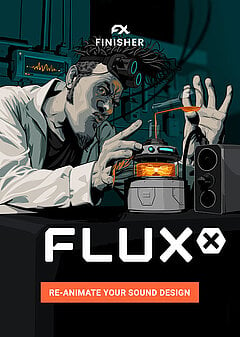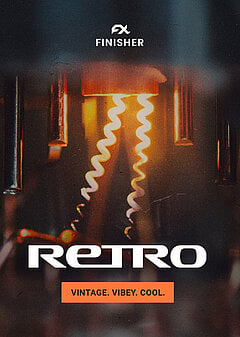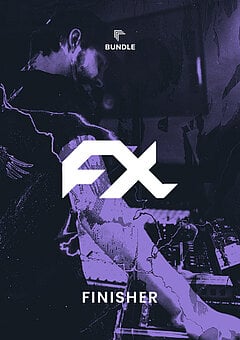The Ultimate Guide to Audio Effects
Discover the fundamentals of EQ, compression, delay, distortion, and phasing, and how they’ll make you a much better producer
MARCH 28TH, 2021
Let’s dive into exactly what you need to know about 5 of the most common audio effects. Understanding how they work can give you a much deeper understanding of them, making you a better and faster producer than the majority of the producers who use them without understanding why. We’ll also mention some differences between analog and digital units and how to blend their sound with our newest plugin, Finisher RETRO! It’s designed to bridge the gap between the two, and we’ll mention presets in places you might find it useful to demonstrate ideas.
If you want to dive deeper into how to use each effect type in the context of a mix, check out our articles How to Mix a Beat and How to Mix Guitars — for a lot more juicy details! This article will help you understand how these tools work and their overall purpose on a broad scale, which is super useful for when you hit a block from always using tools in the exact same way. The 5 audio effects covered in this article are:
EQ
The most fundamental purpose of EQ is to reshape the frequency spectrum of an audio track, either by boosting, cutting back, or completely filtering out certain frequencies. When a mix is cluttered, this is typically the first tool you should reach for to correct the frequency balance and make everything fit together better. EQs work by shifting an audio signal by shifting its phase (its position in time) very slightly, creating new peaks and valleys in the waveform that change its frequency response. In the digital world, there are complex equations that handle this, creating a copy of the signal and introducing ultra small timing delays in the copy to change the sound of the audio passing through.
The basic principle of analog EQ is the same, but the circuit design is very different from its digital counterpart. If you get the opportunity to try a good analog EQ, take it — there’s a warmth in them that’s difficult for digital EQs to replicate! Depending on the EQ, you also might get a cleaner sound from an analog unit when boosting frequencies, versus a digital EQ which could sound thin when you try to push it in the same way. You can cut frequencies safely, however — this often produces a more natural sound.
Compression
This might be the most difficult audio effect to understand, so don’t worry if it doesn’t make sense immediately. In short, compression makes an audio signal sound more consistent — if its volume is all over the place, a compressor will give it more focus; if it has some dynamic range, compressing it will completely squash it. In general, only use compression when you know why you’re using it; otherwise, you may end up completely squashing your audio and sucking the life out of it (i.e. only use it when you know you need it).
A compressor looks at the audio signal coming in and evaluates whether the signal is over the threshold you set and decreases it by a ratio. For example, a 4:1 ratio means that for every 4 decibels (dB) over the threshold, only 1 will make that through — think of it as reducing the volume to one fourth of everything over the ratio. You then use what’s called makeup gain to increase the audio signal back up to the original average volume. In digital compressors this is pretty straightforward — but analog compressors are a bit different ...
In fact, there’s a phrase that became synonymous with the famous LA-76 compressor: “1dB magic.” You could simply run a track through the compressor, apply the slightest amount of compression, and yet it would sound much warmer. With analog compressors, you’re not simply trying to control the volume (because a digital compressor can do that just fine, and for cheaper) — each classic analog compressor has a distinct sound, and sometimes you just want very light compression so you can give a song the sound of a particular hardware unit. In other cases, you want to drive the compressor as hard as you can and watch the compressor try to keep up with it. Analog compressors will fight back sometimes and even struggle, and that’s part of their sound too!
Delay
An incredible tool for turning anything into a rhythmic instrument. Adding delay will create multiple repeat copies of an audio signal that can fill out the space or achieve cool effects — and it’s even more powerful if you time the delay to your DAW’s host tempo (most digital delays will do this by default). Most delays also include filtering options (high and low pass); use them to create separation between the original audio and the copies, otherwise it ends up being a tremendous mess! When you want to give delay a try and need a starting place, try dotted eighths — this is typically the setting best optimized for creating a sense of movement. When used properly, delays can turn almost anything into a percussion instrument by repeating it at regular intervals.
Analog delays have a major, obvious difference from their digital counterparts: their timing is imprecise. No way to sync them to the host tempo! That means your intent with analog delays must be different — you might be tempted to create only timed delays, but you can add whatever timing you like. If you shorten the delay time enough and filter the copies of the note enough, the delay will sound similar to reverb (which is essentially just a bunch of really short delays). To get a sense of a timed delay that emulates the qualities of a hardware unit, try out RETRO’s Orange Phaser preset and see how it fills out the space with a gradually decaying delay.
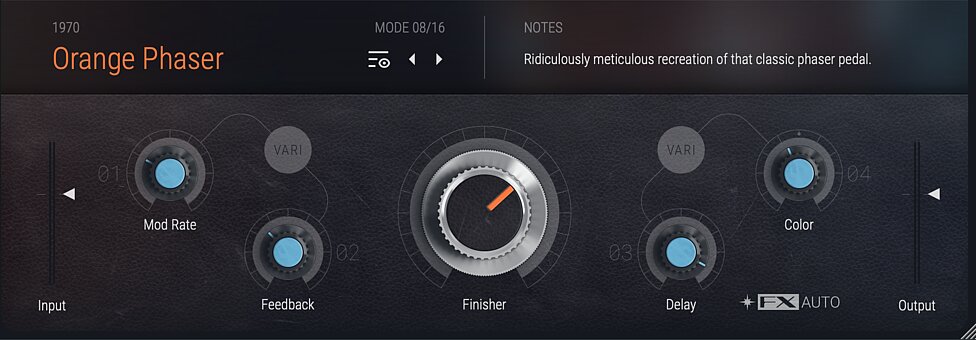
Distortion
This effect adds harmonics to any signal, effectively adding material that didn’t exist beforehand. Distortion can sound angry when it’s used heavily, pleasant when used lightly as saturation, and everything in between. There are many different types of distortion, each with a different sonic profile, so we’ll isolate just a few:
- Digital clipping: created when an audio signal goes above 0dBFS (into the red). A harsh, grating sound devoid of warmth; usually created accidentally, but some engineers enjoy using it on purpose to deliberately add a harsh sound to a song.
- Saturation: a subtle byproduct of many analog EQs and compressors, and created intentionally by dedicated hardware units. The goal is not to be aggressive, but to make the sound feel more warm and alive.
- Bit reduction: the same effect as when you record audio into old video game hardware — you get a gritty, harsh sound that reminds you of retro games. This takes advantage of the limits of old hardware to create a sound entirely unique to the digital world.
- Waveshaping: this type of distortion works via a ‘lookup table’ — a waveform that is multiplied by the signal coming through to create a new sound entirely. This is perhaps the most diverse type of distortion you’ll encounter, especially if you can manually manipulate the wavetable (iZotope’s Trash 2 is a fantastic tool for this).
Distortion is a drastic means of shaping your audio, and over time you’ll likely find that without at least some of it in your mix, things fall flat. A little bit goes a long way (but maybe not on every track) — just make sure you don’t use the same type of distortion on every track! If you don’t add variety to your distortion, your mix will likely sound ‘cheap.’ So use a variety of different distortion types and blend them in until you’re satisfied!
Analog distortion is fun too — while it’s certainly not as versatile as digital distortion, a big factor is once again warmth. If you want to dive more into analog units, the quickest way to get acquainted with them is through guitar distortion pedals since they’re still so widely used. How-To Geek has a fun and enlightening article on guitar distortion pedals that will get you up to speed quickly.
Phasing and flanging
Funny enough, these work on the same basic principle as EQ — duplicate the audio signal and add a slight difference in timing / phase. Only this is for a much longer period of time: a few milliseconds, rather than the fractions of milliseconds necessary to create EQ bands. The frequency response created by phasing is really cool — it looks like a sharp-toothed comb (and is also called comb filtering for that reason). Tons of classic rock groups like Led Zeppelin used phasing and flanging frequently to help create their sound.
At the time this was still pretty new, so to stand out today you need to do a little more than just slap on a phasing plugin and call it a day; that’s why you want to combine it with audio effects like distortion to create a complex, composite sound. When balanced appropriately, more plugins are often better than one!
If you want to play with this effect in more detail, try out RETRO’s preset Dual Ring Modulator — listen to what happens when you take this to the max, as it devolves into a trippy, watery sound perfect for recreating classic 70s rock.
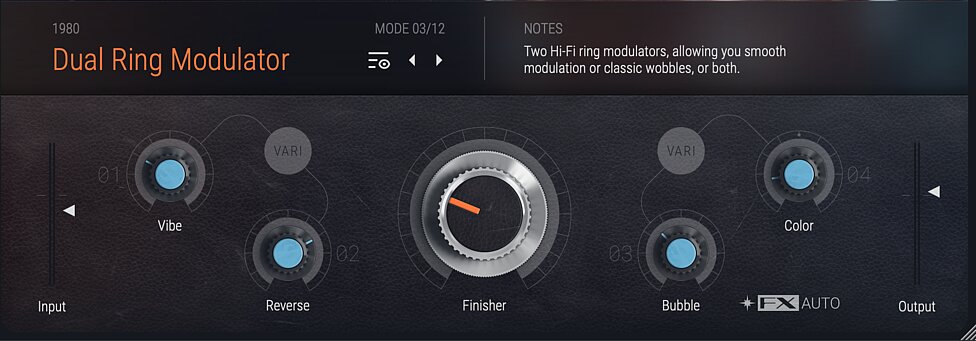
Wrapping up
There are way more effect types than these, but it’s important to understand the fundamentals first before moving onto more complex ones — once you’re comfortable with these, you can add them to your toolbox and know why every time. A ton of digital audio effects come directly from the analog world, and many engineers still swear by their analog tools, which are typically much more expensive! Give analog gear a try whenever you can, but remember that there’s nothing keeping you from producing full songs with digital plugins alone. Make the most from what you’ve got, and if you love the sound of hardware, slowly into your collection as your career and budget allow!
Stay up to date
Sign up and we’ll send you an e-mail with product news and helpful stuff every now and then. You may unsubscribe at any time.
Defy Limits
We develop software solutions that enable people to create, consume and interact with music.
